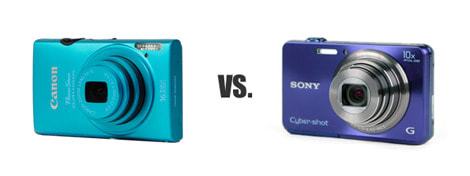Head to Head: Canon ELPH 110 HS vs. Sony WX150
The world of low to mid-range ultracompacts sure is crowded.
 Credit:
Credit:
Recommendations are independently chosen by Reviewed's editors. Purchases made through the links below may earn us and our publishing partners a commission.
In the absolutely saturated mid-range ultracompact market, the battle for top camera can change sides weekly. One model that has distinguished itself is the Sony Cyber-shot WX150, a simple, portable camera with above-average zoom and stronger image quality than the price tag lets on. Our challenger this week is the recently-reviewed Canon PowerShot ELPH 110 HS, one of the most popular point-and-shoots of the year, featuring less zoom than the Sony, but an even smaller footprint.
This is intended to be a brief breakdown of the major differences between the Canon ELPH 110 HS and the Sony Cyber-shot WX150, according to our test results. For a full review of the Canon 110 HS, please go here. To read our full review of the Sony WX150, head over here.

Canon’s PowerShot ELPH 110 HS (left) vs. Sony’s Cyber-shot WX150 (right)
Image Quality
The ELPH 110 HS isn't a sharp camera, but it did manage to fool our tests. This camera's resolution relies on an overdose of sharpness enhancement, so while details are washed out at the edges of the frame, the center is prone to bright halos that result from artificial adjustments. In small prints and web shots the images will look better, but we find rendering like this too distracting. Almost all point-and-shoots also utilizes oversharpening like this, but it's not quite usually as severe. The Sony WX150 has some, but to the edge of the frame it's generally sharper than the ELPH 110 HS.
The Canon 110 HS also produces a bit more noise in its images than the WX150. Noise totals were already over 1.00% at ISO 100, an event that doesn't occur for the WX150 until ISO 800 due to heavier noise reduction. At least the ELPH wins color accuracy, coming in with an uncorrected mean error value of 2.87, which is slightly better than average. Still, we generally prefer images captured with the WX150, all else being equal.
Features & Usability
Both cameras have a compelling design, and the tradeoff here is zoom for portability. If you need a camera that doubles as a bookmark, the ELPH 110 HS is one of the thinnest, lightest cameras out there, even for an ultracompact. The WX150 is a little larger—though not by much, actually—but you get a longer 10x optical zoom.
Each camera has a straightforward user interface, so beginners shouldn't have trouble. Both are also capable of 1080p video recording, though the WX150 captures 30 frames per second, compared to 24 frames per second on the Canon. Burst shooting does represent a significant advantage for the WX150, it's capable of over 10 full resolution frames per second for 10 or 11 consecutive shots, while the ELPH can only manage a fraction of that.
Conclusion
It seems this comparison comes down almost entirely to image quality, but even if it didn't, the WX150 still has more compelling features like 10x zoom, burst capabilities, and slightly smoother video, on top of superior images. At the same price this would be no contest, and indeed the two cameras did release at the same MSRP. But the ELPH has seen a more drastic price drop since release, and can be had for around $30 less than the Cyber-shot. We expect most users will be satisfied with the cheaper option, but Sony's WX150 is the better camera.
For a full review of the Canon 110 HS, please go here. To read our full review of the Sony WX150, head over here.

